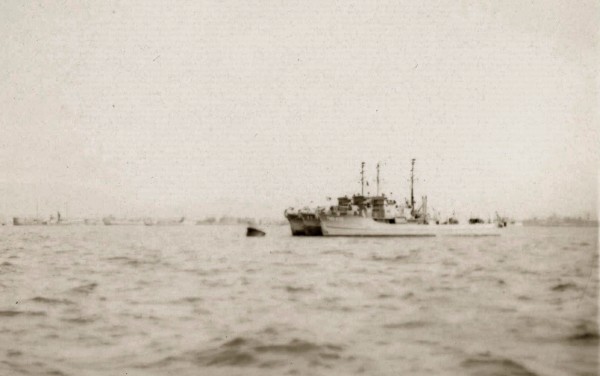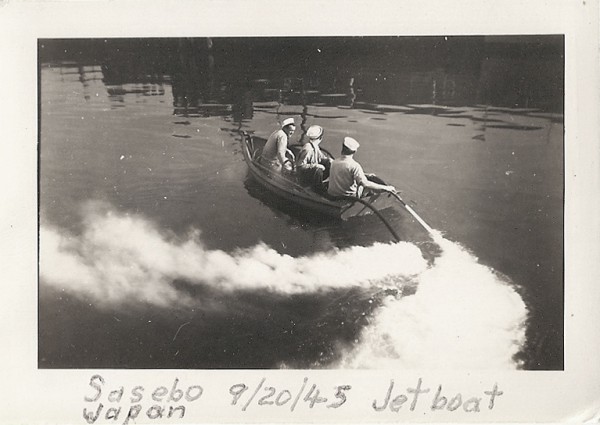Some months ago, I was contacted by a sailor who served aboard a sibling minesweeper across the American, European, and Pacific theatres of WWII. Lieutenant Marty Roberts of Raleigh, NC served aboard YMS-468 as Engineering Officer and later Deck Officer, from 1943 to 1946. Marty wrote up this biography of his naval service for his grandson and was kind enough to share it and his photographs with us.
This post is an eight-part series. Below is an index of all parts. Enjoy!
Marty Roberts of Raleigh, NC | February 28th, 2014
Navy Days – A Letter to Joe
- Part 1: In training
- Part 2: YMS-468 on the US East Coast
- Part 3: YMS-468 through Panama Canal, in prep for battle
- Part 4: YMS-468 on the US West Coast, into the Pacific Theatre
- Part 5: YMS-468 in battle, up to Japan’s surrender
- Part 6: YMS-468 in Makurazaki Typhoon
- Part 7: YMS-468 moored in Japan’s occupation
- Part 8: After the war
Part 6 of 8: YMS-468 in Makurazaki Typhoon
About ten days after the surrender we were ordered to join a task force and proceed to Japan to conduct minesweeping operations in the Kyushu Island area. Our ETA was set for 16 September and we arrived on schedule at the narrow entrance to the outer harbor of Sasebo City. The problem was a major typhoon was following close behind us and we had a choice, ride it out at sea or go in the unfamiliar harbor. We sent one of our ships into the harbor to size up the situation since no US ships had yet been there. The decision was to go in. The larger ships like the AMs (fleet minesweepers) anchored, but the YMS’s were ordered to secure to some large mooring buoys found in the outer harbor; three ships to one buoy. In our case the first two ships shackled anchor chains to the buoy, but our skipper felt that when the wind got strong that buoy would heave around so much it might snap a chain, so we attached our 1″ towing cable instead, the cable having some give to it. Here is a picture of three ships on the mooring buoy.
Around 5 o’clock it began to get dark and the wind really started to blow very hard. In addition to being secured to the buoy our ships were tied together with 6” manila line quadrupled at four points—bow, stern, and two spring line positions. In spite of all this, the wind became so strong it tossed that buoy around so much that the YMS on the starboard side broke its anchor chain and ripped all the lines off and drifted away. The storm intensified to the point the wind got between the bows of our two remaining ships, forcing them apart, stretching the manila lines and then crashing the ships back together again. Too much damage was being done so we decided since we still had both our anchors we would be better off letting go the cable to the buoy and the lines and dropping an anchor. We had our engines running to ease the tension while releasing the lines but the stern line was stretched out so tight it couldn’t be let go from the bits and the men on each ship were using axes to chop off the line. Unfortunately, the men on the other ship got the line free first and the loose end was immediately sucked under our stern and fouled our starboard screw, causing the starboard engine to stop. As we then drifted down wind we dropped one of our anchors which took hold and brought our bow up into the wind.
By this time the wind was so strong it whipped up the waves into a driving froth that cut visibility to practically zero and even disrupted our radar. One of the ships with us was an LCI used for carrying buoys and other equipment. Normally, they served as a landing craft and had a stern anchor for pulling themselves back off the beach. In this case they used it and let out a great deal of cable. Conditions being what they were, it was some time before we discovered we were dragging our anchor and it had snagged the LCI’s anchor cable causing us to slide right up to him before we knew it. Luckily, we got clear after only a light bump amidships that did no damage. However, with both ships essentially on his anchor the howling wind drove us down toward three fleet minesweepers who each had two anchors spread out and couldn’t move. They did see us, however, and radioed, “YMS-468, you are embarrassing us,” as if we did not have enough trouble ourselves! All we could do was let go our anchor, reverse our one remaining engines and hope to back up into the wind and get clear of these other ships and drop our one remaining anchor in a safe location. We succeeded in doing this and rode out rest of the storm which ended about sunrise the next morning.
In preparing for the storm the Exec had what seemed to be a good idea securing our one and only lifeboat normally stowed amidships to the two davits swung out over our squared off stern, complete with outboard engine attached and ready to go. Trouble was we never expected to lose an engine and have to back down into a typhoon driven sea. Consequently, when we backed into the first wave it crashed up under the lifeboat and carried it away in one big swoop leaving just a few short pieces of wood dangling from each davit. Before the beginning of the storm we had raised a brand new flag and the next morning all we had was the white tape with a few red, white and blue threads hanging out of it.
The Japanese name for the storm is the Makurazaki Typhoon of September 17th, 1945 and was the 2nd worst typhoon in their records. In fact it plowed up through Kyushu and Hiroshima resulting in thousands of Japanese deaths caused by torrential rains, flooding, and mudslides.
The next few days were spent recovering from the storm and getting ready for our next operation. During this time we needed some means to get around and somehow the men managed to acquire a Japanese fisherman’s rowboat. That was when I had a great idea. Since our outboard motor went the way of our lifeboat, I thought of a temporary solution. For damage control purposes and pumping out bilges we had a gasoline engine driven pump called a “handy billy” so by putting this in the middle of the rowboat with the suction hose forward and the discharge hose out the back we could get around very nicely. Here is a picture of some of the boys underway.
We also put a hose on the engine exhaust and directed that out back too. I’ve often thought that this is the principle behind today’s recreational jetboat and I missed a great opportunity to start a new industry! Isn’t 20/20 hindsight a wonderful thing!
This post is an eight-part series. Below is an index of all parts. Enjoy!
Marty Roberts of Raleigh, NC | February 28th, 2014
Navy Days – A Letter to Joe
- Part 1: In training
- Part 2: YMS-468 on the US East Coast
- Part 3: YMS-468 through Panama Canal, in prep for battle
- Part 4: YMS-468 on the US West Coast, into the Pacific Theatre
- Part 5: YMS-468 in battle, up to Japan’s surrender
- Part 6: YMS-468 in Makurazaki Typhoon
- Part 7: YMS-468 moored in Japan’s occupation
- Part 8: After the war

